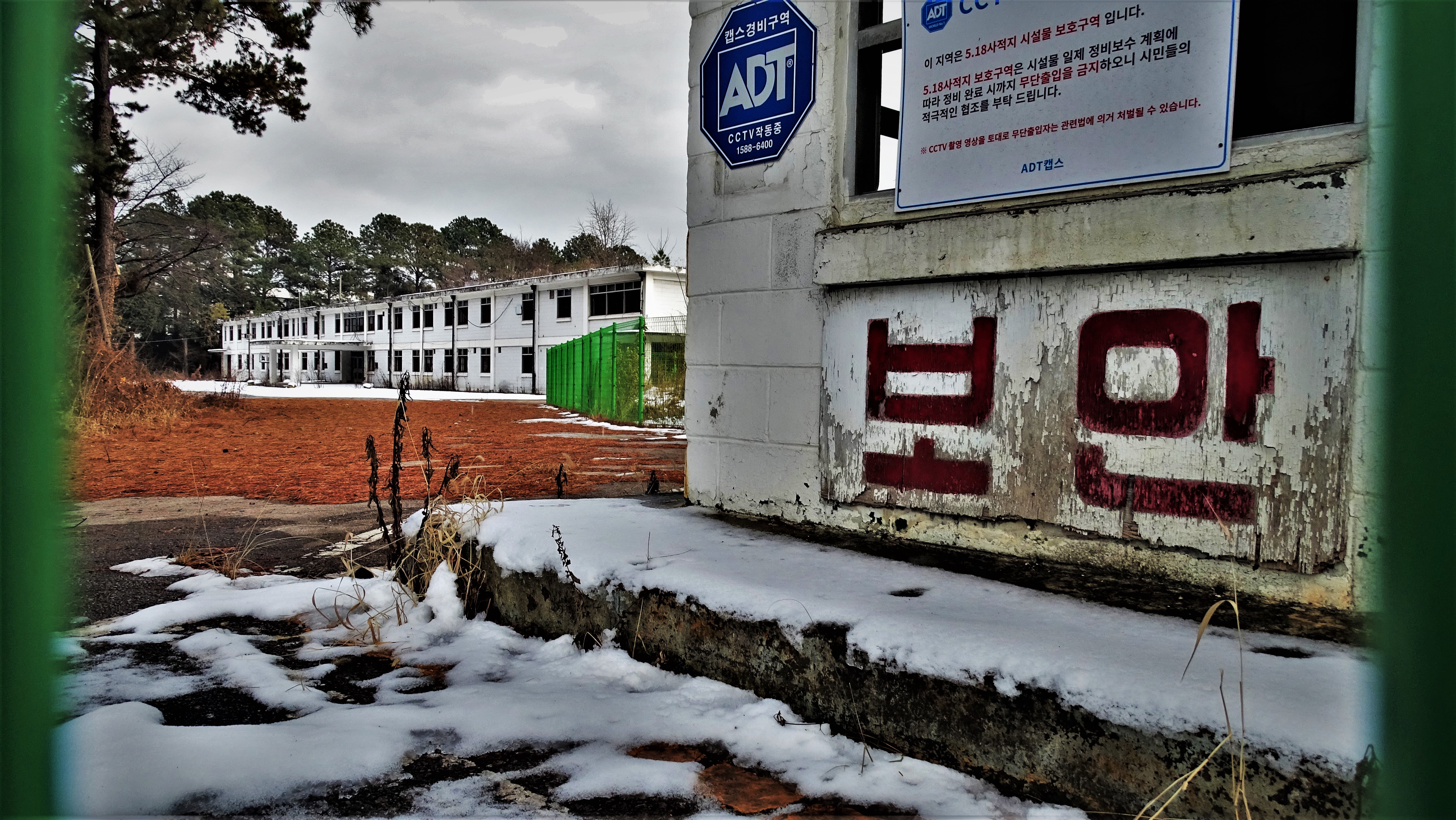Sites of Horror and History Along 5.18 Road
Written and photographed by Isaiah Winters
The elderly in South Korea can be a law unto themselves.
That thought dawned on me when I happened upon a small band of retirees illegally farming a plot of land along 5.18 Road in Ssangchon-dong (쌍촌동). I’m not one to pass judgement, but there really were no two ways about it. The land was part of a derelict building complex protected by high walls, a defunct ADT security system, and multiple signs prohibiting trespassing. What these deterrents were meant to shield were in fact the moldering remains of a former command center with a grim past.
According to the clunkily worded placard out front, this was “the actual command center of the Gwangju Democratization Movement suppression operation.” And yet, despite the site’s important role in South Korean history, there was its battered wooden door – the one chink in the armor – clinging helplessly to a single hinge after what must have been an impressive break-in scene.

Once inside, still more signs – these expressly forbidding farming – stood unheeded. One such sign had a pair of gardening gloves draped cheekily over it, while the others were minded about as much as the chapped crops they overshadowed. Somewhat satirically, these displays of elderly insouciance all took place beneath the main building’s façade, which still bears the faded hanja characters 忠誠 (충성, chungseong), meaning “loyalty” or “fidelity.”
Of course, little from the site’s past merits even a modicum of loyalty. It was the place where the former regional military intelligence unit, known as the 505 Security Forces, was stationed during the Gwangju Uprising. According to the aforementioned placard, the nascent junta “installed a joint investigation unit here and arrested regional democratic figures, leaders of student bodies, [and members of] the Citizens’ Army.” Hauntingly, the placard also attests that arrestees were confined in “dungeons” and subjected to “torturous investigations.”

When walking the grounds, it’s hard not to imagine exactly where these horrific events might have occurred. For instance, one bulky metal door is particularly suggestive, as the rusted keys to its padlock dangle directly across from it at eye level. Another similar door leads to the basement of the main building, where dirty, disconsolate windows to underlit rooms are hemmed in by prisonlike iron latticework. Absent further detail, the mind inevitably fills in the gaps with morbid guesswork.
Fortunately, the city has designated the former command center as a 5.18 (May 18th) historical site and plans to develop the area, so much of what’s currently unknown about the place will likely be revealed sometime in the future. For now, however, it’s better to hold off visiting until the city gives further notice.
Just a few minutes’ walk from the former command center is another morose stop along 5.18 Road that’s both better maintained and less of a mystery.

Designated as a 5.18 historical site twenty years ago, the former Armed Forces Gwangju Hospital is a rather tragic and moving place to visit. According to the placard near the entrance, it was the site “where the citizens who were arrested by the martial forces and tortured during the investigation were brought for treatment.” But that wasn’t the end of their abuse. As a depressing coda, the placard adds that the “dispatched martial law investigators interrogated citizens even here.”
Sadly, it’s quite probable that many who were tortured at the former command center were brought directly here for forced treatment and further interrogation, given the close proximity of the two sites along 5.18 Road.
Today the former hospital’s grounds are a solemn park where visitors can walk paved roads among the site’s many deteriorating remains. These include a brick church, a barracks, rows of hospital buildings, and numerous other structures, all of which have been left standing in their original state. The buildings are clearly labeled (in Korean) on the maps at both entrances as well as on the newly erected fences surrounding them. It’s definitely worth visiting if you have any interest in the history of Gwangju or the Gwangju Uprising.

The former hospital is easily accessible, as it’s conveniently situated between the subway stops at Hwajeong Station (화정역) and Ssangchon Station (쌍촌역).
On a final note, given the awful history of the site, it’s definitely not the kind of place you should be taking selfies at. In fact, some of the elderly visitors may not like to see you snapping photos at all, which is somewhat understandable. On my first visit, one such visitor admonished me for shooting photos, which prompted me to double-check the signboard at the entrance for any bans on photography. Of course, there were none.
But, once again, the elderly in South Korea can be a law unto themselves.
THE AUTHOR
Originally from Southern California, Isaiah Winters first came to Gwangju in 2010. He recently returned to Korea after completing his M.A. in Eastern Europe. He enjoys writing, political science, and urban exploring.





